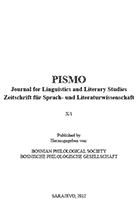Formalističko čitanje Portreta umjetnika u mladosti Jamesa Joycea
A Formalist Reading of James Joyce’s A Portrait of the Artist as a Young Man
Author(s): Ksenija M. KondaliSubject(s): Literary Texts
Published by: Bosansko filološko društvo
Keywords: James Joyce; Portret umjetnika u mladosti; ruski formalizam; postupak; dezautomatizacija (očuđenje); motiv; fabula i siže
Summary/Abstract: James Joyce’s novel, A Portrait of the Artist as a Young Man, was hailed as one of the most captivating novels written in English, primarily due to the innovative use of language and consummate narrative structure. Since its publication in book form in 1916, the novel has been subject of numerous critical readings, ranging from hermeneutical to interpretations triggered in the wake of post-structuralism. However, this article attempts to consider the novel through the perspective of Russian Formalism, an approach to literary theory and analysis which originated in Moscow and St. Petersburg in the second decade of the twentieth century. Drawing on some of the literary terms advocated by Russian Formalists, such as defamiliarization and the distinction between “story” and “plot,” Joyce’s distinctive style and narrative strategies are scrutinized in light of the Formalists’ emphasis on form and method. This article opens with evoking the most widely known Russian Formalist concept of ostranenie (defamiliarization) as presented by Viktor Shklovsky. Claiming that art ought to make the audience see common things in a strange, unfamiliar way, rather than simply resort to an automated recognition of objects as is customary in everyday life, he explored the distortion of our automated perceptions in order to stimulate fresh perception, i.e. to enhance perception of the familiar. Thus Russian Formalists advocated new narrative strategies that would result in a literary language diverting the readers’ attention to its own structure, not only to its content. As the article demonstrates, Joyce’s novel A Portrait of the Artist as a Young Man offers multiple examples in which the author frees the words of their automated perception. Furthermore, the article evokes another idea within Russian Formalist theory, namely that of “motivation”, through the analysis of “motif” as the smallest unit of plot as introduced by Boris Tomashevski. This prominent conception of Russian Formalism serves as another prism in analyzing Joyce’s novel, whose main motifs constitute, among others, songs, hymns, Latin phrases, and flight. These motifs act as means to slow down, halt or distort the action in the novel in order to undermine the ordinary, typical procedure, similarly evoked in the method of defamiliarization in language. Lastly, the distinction between “story” ( fabula) and “plot” (sjuzet), which occupied an important place in Russian Formalism, is also applied in this critical reading of Joyce’s novel. As a work of fiction that cleanly breaks from earlier literary practice, Joyce’s novel A Portrait of the Artist as a Young Man can thus be viewed as a harbinger of a different, original understanding and practice of literary narration. By challenging the prescribed literary modes of his time in this novel, James Joyce, like the Russian Formalists, can be said to have instigated a new, innovative approach toward literature.
Journal: Pismo - Časopis za jezik i književnost
- Issue Year: 2010
- Issue No: 08
- Page Range: 229-248
- Page Count: 17
- Language: Bosnian

